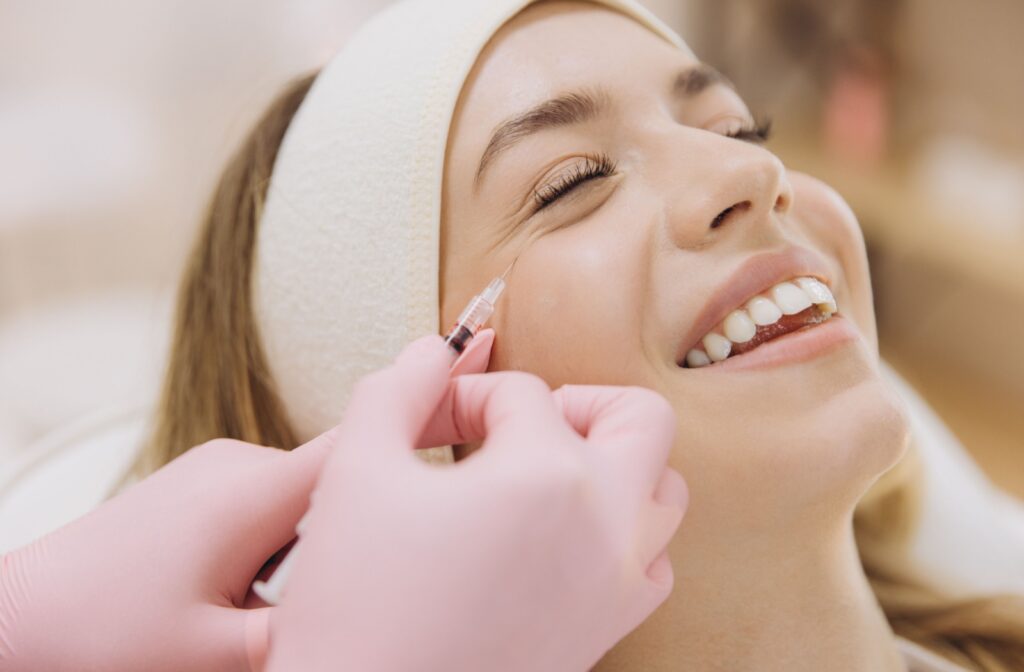You may know Botox for its use in smoothing wrinkles, but you might also have questions about how Botox-based procedures can affect your eyes.
Botox injections near the eyes can sometimes cause temporary changes to your eyesight. These effects are typically mild and resolve on their own as the treatment wears off, but understanding how they work can help you prioritize your eye health.
How Botox Works Near Your Eyes
Botox works by relaxing the muscles it’s injected into, which helps reduce the appearance of lines created by facial movements. The goal is to isolate the treatment to only the intended areas.
Sometimes, the product can spread a small amount and affect the nearby muscles you use to control your eye movements. This unintended movement is what can lead to temporary visual side effects. An experienced practitioner understands facial anatomy and can place injections precisely to reduce this possibility.
Common Vision Changes After Treatment
Most vision-related side effects from Botox are mild and temporary. They occur when Botox affects the intricate muscles that control how your eye functions. These changes are not usually a cause for alarm and they tend to fade over time.
Droopy Eyelids
One of the more common side effects is a temporary droop in one of your eyelids, a condition also known as ptosis. This occurs if the substance moves into the muscle responsible for holding your upper eyelid up.
A droopy eyelid can make your eye look smaller or feel heavier than usual. While this can be a cosmetic concern, it typically doesn’t impact your clarity of vision. The effect is temporary and the eyelid should return to its normal position as the Botox wears off.
Blurred or Double Vision
If the muscles that control your eye movement are affected, you might experience temporary blurred or double vision. This can happen when your eyes struggle to align correctly, a temporary issue similar to what occurs in conditions like strabismus (crossed eyes). Your brain receives two different images, leading to a brief period of visual confusion.
This side effect usually resolves on its own without intervention. It’s a direct result of the muscle-relaxing properties of your Botox treatment affecting adjacent areas. As the product fades from those muscles, your eyes should once again work together properly.
Dry & Irritated Eyes
After an injection near the eyes, you might notice some temporary dryness and irritation. This can happen if your blink reflex is slightly altered or if your eyelids don’t close completely. This reduced blinking can prevent your tears from fully coating the eye’s surface.
Over-the-counter lubricating eye drops can often help soothe any discomfort, and the feeling of dryness typically subsides within a few weeks.

How Long Do Vision Side Effects Last?
For most people,vision changes associated with Botox treatments aren’t permanent. Side effects like a droopy eyelid or blurred vision fade as the effects of the treatment wear off. Your body gradually metabolizes the product, allowing the affected muscles to regain their normal function.
This process can take anywhere from a few weeks to three or four months. If you have any concerns about how long your symptoms are present, it’s a good idea to follow up with your provider. They can offer reassurance and monitor your progress.
Steps for a Safe Procedure
There are a few steps that you can take to make your Botox treatment a positive experience. Proper preparation and care can help you get the results you want.
Choose a Qualified Professional
Select a practitioner who has extensive experience with facial anatomy and Botox injections. A qualified professional knows how to target the correct muscles precisely. This helps reduce the risk of unwanted side effects like vision changes.
Look for a provider who is licensed and has a strong portfolio of results. You should feel comfortable asking them about their training and how many procedures they’ve performed. A great practitioner will welcome your questions.
Talk About Your Health History
Have an open conversation with your provider before your treatment. Discuss any eye conditions you have, such as glaucoma or chronic dry eye, and mention previous cosmetic procedures or eye surgeries. This information helps them tailor the treatment to your needs.
A number of health factors can influence how your body responds to Botox treatments, so it’s also important to share a full list of your current medications and any known allergies.
Follow Pre & Post-Treatment Care
Your provider will give you instructions for before and after your appointment. Following these directions is important to keep the substance from spreading to unintended muscles. This often includes avoiding strenuous exercise for 24 hours.
You’ll likely be advised not to rub or massage the treated area for a set period of time. You may also be told to stay upright for several hours after the injection. Adhering to these simple guidelines helps the product stay where it was placed.
When to Discuss Vision Concerns with a Professional
It’s helpful to know the difference between typical, temporary side effects and symptoms that need more attention. Being proactive allows you to address any concerns quickly.
What to Watch For After Your Injection
Pay attention to how your eyes feel and function in the days and weeks after your procedure. While mild effects can be part of the process, you may want to contact a professional if you experience:
- Vision changes that become worse instead of better
- Significant eye pain or discomfort
- Signs of an infection or allergic reaction, like major swelling or redness
Why Preventative Eye Care Matters
Your eye health is important whether you get cosmetic treatments or not. A comprehensive eye exam provides a full picture of your ocular health and establishes a baseline for your vision. This makes it easier to track any changes that may occur over time.
Regular check-ups with your eye doctor can help monitor your vision and address any issues early. At Total Vision Little Tokyo, we offer comprehensive exams for your whole family. Schedule an appointment today to support your long-term vision health.



